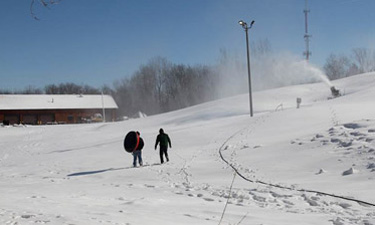 Still think you need mountains to get your snowboarding fix? Think again. Urban snow parks are an emerging trend, and city/county facilities can provide the perfect location. While traditional snowboarding and skiing require a large area and sufficient pitch, snow parks – also known as terrain parks or rail parks, after the rails that form the most common trick element–can be small and do not require steep runs. They can be lit for night-time use and benefit from snow-making capabilities, both to establish a good base and to shape the snow on the slope. With good design, even the most accomplished snowboarder can happily spend an entire day at a small urban snow park. Think skate park, but on snow.
Still think you need mountains to get your snowboarding fix? Think again. Urban snow parks are an emerging trend, and city/county facilities can provide the perfect location. While traditional snowboarding and skiing require a large area and sufficient pitch, snow parks – also known as terrain parks or rail parks, after the rails that form the most common trick element–can be small and do not require steep runs. They can be lit for night-time use and benefit from snow-making capabilities, both to establish a good base and to shape the snow on the slope. With good design, even the most accomplished snowboarder can happily spend an entire day at a small urban snow park. Think skate park, but on snow.
To date, only a handful of urban snow parks have been developed throughout North America, with the first being Ruby Hill Rail Yard in Denver, Colorado, and others in Toronto, Canada (Ripley’s Urban Rail Park at Polson Pier), and Portland, Maine (Payson Hill Terrain Park). Hawk Island Snow Park, within Hawk Island County Park in Lansing, Michigan, is the newest addition to this select group. Originally planned as a tubing hill only, the idea for the terrain park was initiated by a group of winter sports enthusiasts, including co-author Pete Bosheff and Modern Skate and Surf owner George Leichtweis, both of whom had previously been involved with the development of the Ranney Skate Park in Lansing, ranked in the top 10 skate parks in the country by a National Geographic publication in 2009. Design of the snow park has been led by Bob Ford, owner of Lansing-based firm Landscape Architects and Planners (LAP).
The main challenges? Since the tubing hill is funded by a Land and Water Conservation Fund grant, administered by the Michigan Department of Natural Resources, with monies tied specifically to that effort, successful implementation of the terrain park project has relied heavily on the donation of time, effort, and equipment from local businesses, winter sports industry sponsors, and private donors–a genuine example of how hard work, non-traditional partnerships, and collaboration can pay off. As further evidence of the commitment of LAP and the county parks department to an all-inclusive and participatory design and operation process, a group of interested youth and college students–who have named themselves the Hawk Island Action Sports Operations Committee–has been formed to aid in the design process and help garner support and generate enthusiasm among younger community members. A Facebook page established in October 2011 has already attracted 854 friends, and a Twitter account has also been set up (@UrbanSnowParks) in preparation for the opening of the park in two months ago. For the Hawk Island staff and managers, the operation of a snow park is an entirely new concept and some of the challenges faced and skills required–such as operating snowmaking and grooming machines–are rather unique.
The learning curve has been steep, though it has been softened by multiple interactions with industry professionals and manufacturers more experienced with these kinds of facilities. Liability has not been an issue, since the park’s existing insurance policy has been deemed to provide adequate coverage. Toboggans and sleds will not be allowed in the terrain park due to their incompatibility with boards–there is no way to control or stop a sled or toboggan–though terrain park skis will be welcome.
And what will be the benefits? An urban snow park provides diverse populations of city residents – of all socioeconomic and racial/ethnic backgrounds–with easy, inexpensive access to a fun new outdoor winter activity, at the same time extending Hawk Island from a seasonal community attraction to a year-round destination. Urban snow parks provide access and a warm welcome to all. Youth in particular are constrained from visiting terrain parks at traditional ski resorts both by the time and cost to reach them (hours of driving or an airplane ride), and the cost of lift tickets, which can range from $50 to $100 per day. A day ticket at Hawk Island is $7, and season passes are available for $99. Smaller, nearby urban parks offer serious riders the opportunity for more frequent participation as well as more interaction with the terrain elements on each visit since less time is needed riding lifts to reach them. An increasing proportion of Olympic and Winter X Games athletes learned their trade at small, local parks rather than in the big mountains. The ease of access to urban facilities may pay dividends for the more distant ski resorts in the long run, too–numbers of snowboarders have plateaued at resorts in recent years, and so urban snow parks may serve as a means of attracting first-timers to this activity, thereby potentially generating new ski area customers once they get hooked on the sport.
Sarah Nicholls, Ph.D., is an associate professor in the Departments of Community, Agriculture, Recreation & Resource Studies, and Geography at Michigan State University. She also serves on the Ingham County Parks and Recreation Commission. Pete Bosheff is Principal of Urban Snow Parks LLC. Brian Collins is Manager of Hawk Island County Park and Willis Bennett is Director of Ingham County Parks.

